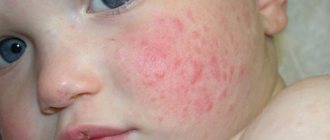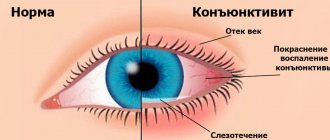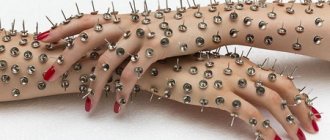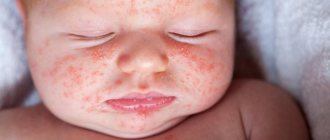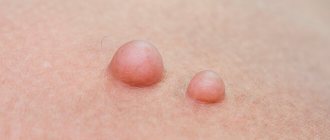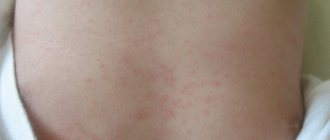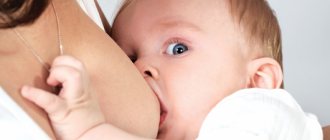Symptoms of diathesis in children, treatment and prevention measures
Diathesis (allergic dermatitis, a child’s tendency to various allergic diseases) in the form of bright red cheeks in children most often appears from one to three years of age. In this case, such symptoms may occur in a baby who has not previously had any problems with digestion, allergies, or skin. Such spots appear rather crowded, in most cases they are located on the cheeks, but can also spread to the neck, chest, and inner surfaces of the elbows.
The child becomes irritable and constantly wants to scratch his itchy cheeks, which only makes the itching worse, and his cheeks become sore. Subsequently, such diathesis spots become crusty, peel at the edges, and may become wet. The child's stool is disrupted, constipation or diarrhea appears, the baby complains of a sore throat or cough.
Causes of diathesis
There are many causes of diathesis, occurring both in the prenatal period and at birth. These include:
- Hereditary factors and predisposition to skin and immune diseases.
- Use of medications during pregnancy.
- An environment with harmful impurities from industrial production, gas pollution, and dust.
- Early introduction of complementary foods.
- Infections. Expressed in bacterial and viral effects.
- Disturbance of the microflora of the gastrointestinal tract.
- Disruption of the digestive system.
- Lost sleep pattern.
Closely monitor your child's diet. If you need to create a menu, consult your doctor. Independent experiments with the child’s body will only worsen the baby’s condition.
Improper nutrition of the mother during pregnancy and breastfeeding are common causes of diathesis. Consumption of egg and milk proteins, citrus fruits, caviar, canned food, berries and honey cause an allergic reaction even in adults. Rarely, allergies due to natural breast milk occur, and treatment of diathesis in children under one year of age is more difficult than in older adults.
Clinical researches
The conducted clinical study proves the high efficiency, safety and tolerability of the product for daily skin care of children with mild and moderate forms of atopic dermatitis and during remission, accompanied by a decrease in the quality of life of patients. As a result of therapy, a decrease in the activity of the inflammatory process, a decrease in dryness, itching and flaking was noted.
It has been clinically proven that La-Cri cream for dry skin eliminates dryness and flaking, retains the skin's own moisture, and protects the skin from wind and cold.
Sources:
- Fokina R.A., Atopic dermatitis: stages of development of classification forms, Siberian Medical Journal, 2007 https://cyberleninka.ru/article/v/atopicheskiy-dermatit-etapy-razvitiya-klassifikatsionnyh-form
- A.N. Pampura, A.A. Chuslyaeva, Modern approaches to the treatment of atopic dermatitis in children https://cyberleninka.ru/article/v/sovremennye-podhody-k-terapii-atopicheskogo-dermatita-u-detey
Photos of diathesis
Photo album on the disease
Kinds
Depending on the individual characteristics of the body and some external factors, diathesis may vary. In medical practice, the following types of childhood diseases can be diagnosed:
- Exudative-catarrhal or allergic diathesis. The most common type is allergic; it occurs in infants aged 3–6 months and can disappear under favorable conditions by 1–1.5 years without a trace or develop into a chronic form of allergy.
- Hemorrhagic. Hemorrhagic diathesis in children is a clinical and hematological syndrome that includes a whole group of acquired and hereditary diseases. A common feature is a severe and rather dangerous predisposition of a small organism to bleeding. Any violation of the vascular wall can lead to severe external or internal bleeding.
- Neuro-arthritic. The phenomenon is quite rare, but represents a serious disease. The reason for its development is disorders of protein metabolism, genetically determined. An increased amount of uric acid is deposited in the joints in the form of crystals. Therefore, this form of childhood diathesis is practically impossible to correct and persists throughout life. So the treatment of diathesis in infants and older children in this case is aimed at maintaining the general condition of the baby.
- Exudative. Exudative diathesis in medical practice is also called atopic dermatitis. This is not so much an independent disease as a constitutional feature of the child. It is based on intolerance to certain foods, which causes various disturbances in water and fat metabolism. Allergies can be caused by cow's milk, honey, egg whites, chocolate, citrus fruits, cocoa, strawberries and other products. Another name for the disease is exudative-catarrhal diathesis.
- Uric acid. A disease characterized by metabolic disorders in the process of formation and filtration of urine. In this state, salts in the form of sand precipitate in a red color and then crystallize. The consequence is urolithiasis. The analyzes reveal serious violations of the qualitative composition of children’s urine, as well as its daily quantity. Indicators such as acidity and density change: they increase.
Each variety has a specific set of characteristics and differs in its genesis and treatment. Diathesis is always especially difficult in children under one year of age, which disrupts the baby’s normal routine. The causes of the disease can be a variety of factors - determined not only by the internal characteristics of the body, but also by external circumstances.
general information
From the point of view of modern medical science, diathesis is defined as a constitutional feature that determines the body's reactions to certain factors. It can become a risk factor for the development of certain diseases, not only in childhood, but also in adulthood and even in old age. Doctors count more than 20 different types of anomalies, against which up to 90% of diseases that become chronic develop. The most common are:
- exudative-catarrhal form, which is characterized by allergic reactions (mainly skin) and reduced resistance to infections;
- lymphatic-hypoplastic form, which is based on insufficient function of the thymus gland, which causes enlarged lymph nodes in children, poor functioning of the adrenal glands, and development of allergic diseases;
- neuro-arthritic form, accompanied by increased nervous excitability and manifested in joint pain, night terrors, enuresis, stuttering, etc.
In addition, some children experience uric acid or salt forms of diathesis, which manifest themselves in an imbalance of uric acid or salts in the urine with the loss of crystalline deposits. The hemorrhagic form is associated with blood clotting disorders, increased permeability of the vascular wall and bleeding. The exudative-catarrhal form is expressed in disturbances in the bacterial balance of the digestive tract, which can lead to the development of chronic intestinal disease.
Symptoms and signs of diathesis, photos
What does diathesis look like in a child (see photo)? It is not difficult to recognize the disease:
- cheeks turn red and peel;
- wet areas appear in many places;
- the spots become bright red, covered with visible bubbles;
- the rashes itch;
- Red spots appear on the legs, buttocks, and elbows
- mucous membranes become inflamed;
- the crown is covered with grayish scales;
- seborrheic crusts form on the head;
- Diaper rash lasts a long time and is difficult to treat.
Most cases of diathesis have been recorded in infants and children under one year of age. An allergic reaction develops in the first months of life due to the imperfection of many body systems.
In children 2–12 years old, the disease can develop into adolescence. Symptoms of diathesis in children:
- after contact with an allergen, rashes appear on the skin;
- some areas of the body turn red;
- itching occurs;
- The child is sweating for no reason.
After 15 years the manifestation disappears. If this does not happen, neurodermatitis develops. Symptoms:
- dry, hard skin in the perineum, elbows, hips, and other parts of the body;
- manifestations of neurodermatitis intensify under the influence of provoking factors.
In some cases, the tendency to allergies is inherited.
Diagnosis and treatment of diathesis
The doctor determines how to treat diathesis on the cheeks of a child depending on the diagnosis performed. It includes a general urine test, general and biochemical blood tests, an immunological examination, and a stool test for dysbacteriosis. In case of lymphatic-hypoplastic diathesis, additional examinations are required: radiography of the respiratory organs, ultrasound of the liver, lymph nodes, spleen and adrenal glands.
How to treat diathesis in children under one year of age and older:
- Follow the diet and feeding schedule prescribed by your doctor.
- Introduce complementary foods no earlier than 6 months.
- Limit consumption of cow's milk.
- Enrich your diet with vitamins.
- Use prescribed medications: antihistamines, absorbents, vitamins, antipruritics.
As a local treatment, an ointment made according to the original recipe “PsorMak” is used. It does not contain hormones or other harmful components, and contains only natural ingredients that are gentle on the skin.
If in childhood a child undergoes a course of effective treatment for diathesis, then he has every chance of not encountering complications and being absolutely healthy in adulthood. Here it is important to contact a specialist in time. The PsorMak clinic practices an individual approach to the treatment of each patient, developing not only a treatment regimen, but also a diet, as well as a prevention program.
Contact us through the form on the website or by calling +7 (495) 150-15-14. We will help you form a correct understanding of the disease itself and its treatment at all stages.
Treatment of exudative-catarrhal diathesis
This type of pathology can only be cured comprehensively. First of all, you need to follow a daily routine and diet.
The diet includes:
- Limiting cow's milk. It is better to partially replace the mixtures with fermented milk products.
- Maintaining a strict feeding schedule.
- Introduction of complementary foods to infants no earlier than 6 months.
- Enriching the diet with vitamins;
- Exclusion of fatty meats, broths, citrus fruits, bananas, strawberries, honey, tomatoes, nuts, cocoa, chocolate, smoked meats.
Drug treatment:
- In severe cases, Histaglobulin is prescribed after a preliminary test.
- Antihistamines: Fenistil, Zyrtec, Suprastin.
- Absorbents – Enterosgel, Smecta.
- To improve sleep and reduce itching, use Phenobarbital, Barbamil, Valerian.
- Calcium salts.
- Vitamin therapy: Thiamine bromide and chloride, Retinol acetate, Calcium pangamate, Ascorbic acid, Pyridoxine hydrochloride, Rutin, Riboflavin.
- For infectious skin inflammations, antibiotics are prescribed - Ampiox, Gentamicin;
- For lethargy and adynamia, Thyroidin is used.
- For constipation - Duphalac, systemic intake of Magnesium sulfate orally.
You can smear the affected areas of the skin on the butt and cheeks with the following remedies for diathesis:
- Pasta Lassara.
- Silver nitrate.
- Chamomile infusion or boric alcohol solution.
- Talkers with talc, zinc.
- For skin infections, use brilliant green, iodine, Castellani paint, and geolymicin ointment.
For diathesis accompanied by severe itching and severe dermatitis, hormonal ointments are indicated:
- Dermozolon, Oxycort;
- Flucinar;
- Prednisolone ointment.
In addition, for diathesis you can use ointments and creams that have a drying and antiallergic effect:
- Sudocrem;
- Fenistil;
- Advantan;
- Zinc ointment;
In case of severe skin lesions, the child can be bathed in a bath with herbal decoctions of violet, string, chamomile, and oak bark. After the bath, the baby's body is treated with sour powder.
Neuro-arthritic diathesis
With neuro-arthritic diathesis, it is important to follow a diet. What can you feed your baby:
- fruits vegetables;
- products made from rye flour;
- cereals containing starch;
- milk products.
Diet restrictions:
- fats;
- sweets;
- mushrooms;
- meat, including poultry;
- nuts;
- fish.
Complete refusal of such products:
- cocoa, coffee;
- offal;
- chocolate;
- carbonated drinks;
- legumes;
- rich broths.
Drug therapy is based on drugs that affect the synthesis of uric acid, its excretion and reduction in the level of ketone bodies:
- Allopurinol;
- Urodan;
- Etamide;
- Calcium pantothenate.
Choleretic, sedatives, and B vitamins are also used. For acetonemic vomiting, gastric lavage and a cleansing enema are necessary.
Folk remedies
There are a large number of recipes used in the treatment of diathesis with folk remedies:
- A decoction of crushed wheatgrass root: give the composition to the child several spoons a day.
- Water infusion with burdock root. Daily use of 3-4 tbsp. per day will give results within the first weeks.
- Bathing a child with the addition of a decoction of string with chamomile. The procedure relieves irritation, itching, and discomfort.
- 3 tbsp. Viburnum bark is poured with 2 cups of boiling water and boiled for half an hour. One teaspoon a day is enough for a quick cure.
- The shell of an egg boiled and washed with soda takes 2-3 days to dry. Afterwards it is crushed to be added to regular food. The discomfort caused by diathesis disappears.
Diet therapy is the way to treat diathesis
A hypoallergenic diet is an important link in the complex treatment of children suffering from diathesis. However, in order not to provoke a deficiency of vitamins and nutrients, it is important to replace prohibited foods with equivalent beneficial properties.
Diet therapy should always be prescribed by a doctor. Self-medication is fraught with dangerous consequences, since it cannot take into account the properties of the detected allergens, the severity and severity of the allergic process, the age, weight of the child and other features of the baby’s development.
It is necessary to distinguish between allergies and allergic diathesis. An allergy is an inadequate reaction of an already formed immune system to safe substances. Diathesis is associated with age-related characteristics and immaturity of the gastrointestinal tract, as well as with increased histamine sensitivity in children in the first years of life.
Olesya Butuzova, pediatrician: “The diet for diathesis should be individual. There is no point in depriving your child of a large number of foods that are considered potential allergens. By keeping a food diary, mom can easily identify pest foods. They are the ones who need to be eliminated! Remember that sweets are not recommended for children under 2 years of age; later, marshmallows, marshmallows and jam are allowed. Chocolate is strictly prohibited until 3-4 years.”
Author: Elena Nersesyan-Brytkova
The material uses photographs belonging to shutterstock.com
Baby care
As a rule, the tendency to allergies is not limited to skin manifestations, and over time the child's sensitivity to other potential allergens increases. To reduce the risk of sensitization of the child’s body, follow a number of basic measures:
- Use clothes only made from natural fabrics.
- Wash your baby's clothes and diapers, as well as your own home clothes, with special baby powder or baby soap, and then iron them (high temperature destroys allergens).
- Do not have pets, and if you already have one, avoid contact between the animal and the child. The animal should not enter the room where the baby sleeps.
- Do not give your baby soft toys, and check hard toys made of plastic and rubber for a quality certificate.
- Try to do wet cleaning at least in the baby's room every day.
- Minimize the number of “dust collectors” (upholstered furniture, carpets, books and clothes in uncovered closets, etc.) in the baby’s room.
- To care for your child's skin and hair, use special medicinal children's cosmetics. It is not necessary to purchase expensive brands, but it should be medicinal cosmetics (Emolium, Lipikar lines, creams such as Bepanten, Skin-cap, Topicrem). Special products carefully moisturize the skin without causing irritation or allergic reactions.
If your child is sick, do not give him medications without a doctor's prescription - many medications contain allergenic flavors and dyes.
Diet for diathesis in children
The nutrition of children with diathesis should be selected individually: you cannot simply exclude all potentially dangerous foods from the baby’s diet and wait for recovery. The child’s nutrition must be balanced, so only an experienced pediatrician, allergist or nutritionist can entrust the preparation of the menu. Those products that are included in the list of undesirables must be compensated by their permitted analogues. If it is not possible to find an appropriate replacement, the doctor prescribes the necessary vitamins orally.
Typically, doctors recommend excluding from the diet seafood, fruits, berries and vegetables of red, yellow and orange colors, exotic fruits, sweet pastries, sweets, condensed milk, chocolate, coffee, cocoa, wheat and gluten-based dishes, nuts, honey, mushrooms , semi-finished products, artificial seasonings. Also excluded from the diet during diathesis are smoked meats, chips, carbonated drinks with flavors and dyes, and jelly (it is advisable to exclude the latter from consumption due to their high content of starch and sugar).
What can a child eat if he has diathesis? The least dangerous products that are usually recommended are:
- Porridges cooked in water without adding sugar or fruit (rice, buckwheat, corn, millet). It is better to temporarily abstain from semolina and wheat porridge.
- Fermented milk products in the absence of an allergy to cow's milk protein.
- Green and white vegetables and fruits (zucchini, squash, Brussels sprouts, Beijing sprouts, cabbage, cauliflower, savoy cabbage, broccoli, apples, cucumbers).
- Meat (turkey, rabbit, lean pork, beef is allowed, provided there is no allergy to cow's milk protein).
As for the method of preparing dietary dishes, it is preferable to boil, steam or bake them, and avoid fried foods. In no case should the child be overfed: meals should be fractional, feed the baby in small portions.
Unfortunately, many children do not understand the reasons for the restrictions, and strive to eat forbidden foods - chocolate, cake, strawberries, and so on. When explaining why a son or daughter should not eat certain dishes, parents need to be gentle and at the same time persistent. Over time, the child realizes the connection between what he is and his own state of health.

